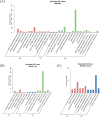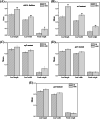Transcriptome analysis of the growth-promoting effect of volatile organic compounds produced by Microbacterium aurantiacum GX14001 on tobacco (Nicotiana benthamiana)
- PMID: 35448945
- PMCID: PMC9028074
- DOI: 10.1186/s12870-022-03591-z
Transcriptome analysis of the growth-promoting effect of volatile organic compounds produced by Microbacterium aurantiacum GX14001 on tobacco (Nicotiana benthamiana)
Abstract
Background: Plant growth-promoting rhizobacteria (PGPR) release volatile organic compounds (VOCs), which promote plant growth.
Results: A potential PGPR strain GX14001 was isolated from marine samples, and the VOCs produced by GX14001 significantly promoted tobacco (Nicotiana benthamiana) growth in a plate experiment. Based on 16S rRNA sequence alignment and physiological and biochemical characterization, GX14001 was identified as Microbacterium aurantiacum. Comparative transcriptome analysis was conducted between GX14001 VOCs-treated tobacco and the control; it was found that 1286 genes were upregulated and 1088 genes were downregulated. Gene ontology (GO) analysis showed that upregulated genes were involved in three biological processes: polysaccharide metabolic, polysaccharide catabolic and carbohydrate metabolic. The downregulated genes were involved in six biological processes, namely cell redox homeostasis, cellular homeostasis, carbohydrate metabolic process, homeostatic process, obsolete electron transport, and regulation of biological quality. Kyoto encyclopedia of genes and genomes (KEGG) pathway analysis showed that 190 upregulated differentially expressed genes were mainly involved in plant hormone signal transduction, phenylpropyl biosynthesis, plant-pathogen interaction, and flavonoid biosynthesis. The 148 downregulated differentially expressed genes were mainly involved in plant hormone signal transduction and the metabolism of ascorbic, aldehyde, and pyruvate acids. Further analysis revealed that many genes were differentially expressed in the metabolic pathways of plant hormone signals, which were speculated to be the main reason why GX14001 VOCs promoted tobacco growth. To further study its regulatory mechanism, we found that GX14001 promoted plant growth through auxin, salicylic acid, and gibberellin in Arabidopsis mutant experiments.
Conclusion: The VOCs produced by Microbacterium aurantiacum GX14001 may promote the growth of tobacco through the auxin, salicylic acid and gibberellin pathways.
Keywords: Plant growth promoting rhizobacteria (PGPR); Plant growth promotion; Promotional mechanisms; Transcriptome analysis; Volatile organic compounds (VOCs).
© 2022. The Author(s).
Conflict of interest statement
The authors declare that they have no competing interests.
Figures








References
-
- Thakur N. Organic farming, food quality, and human health: A trisection of sustainability and a move from pesticides to eco-friendly biofertilizers. Probiotics in Agroecosystem. 2017:491–515. http://doi.org/10.1007/978-981-10-4059-7_26
MeSH terms
Substances
Supplementary concepts
LinkOut - more resources
Full Text Sources

